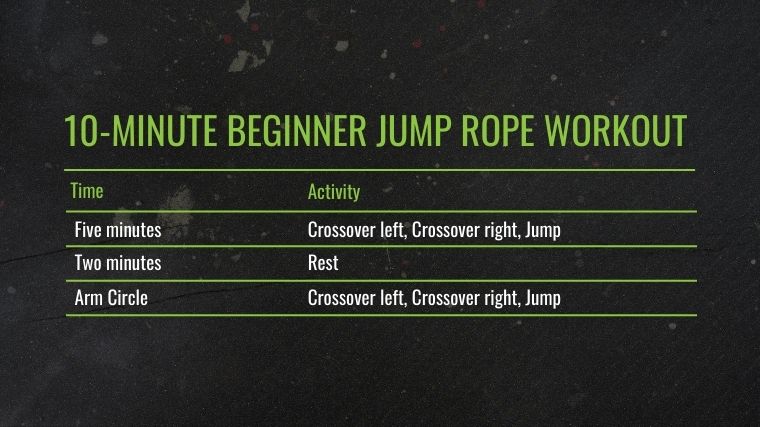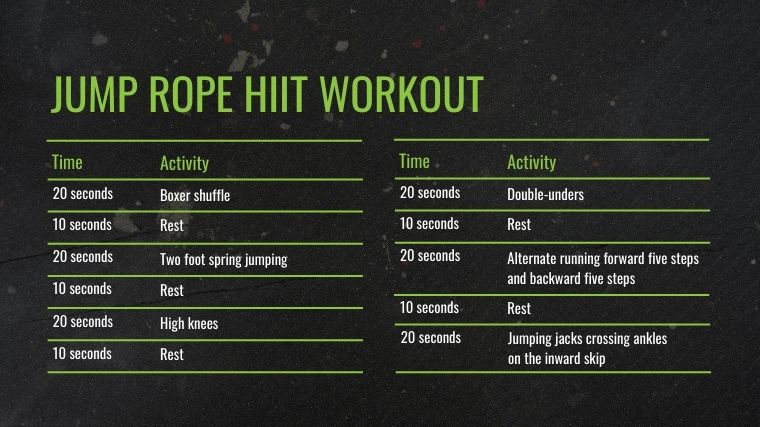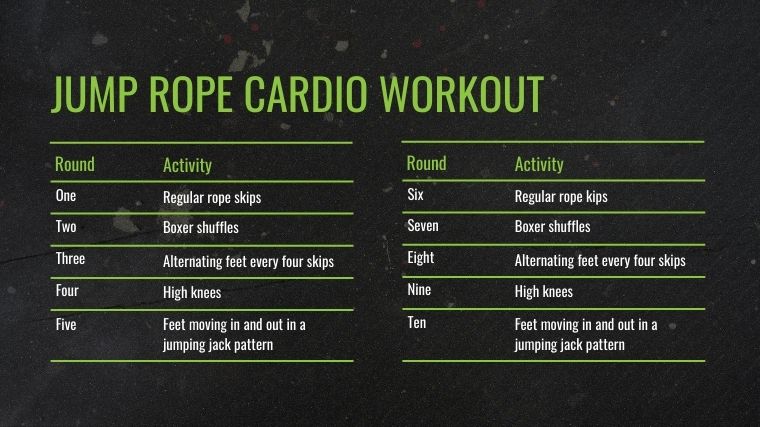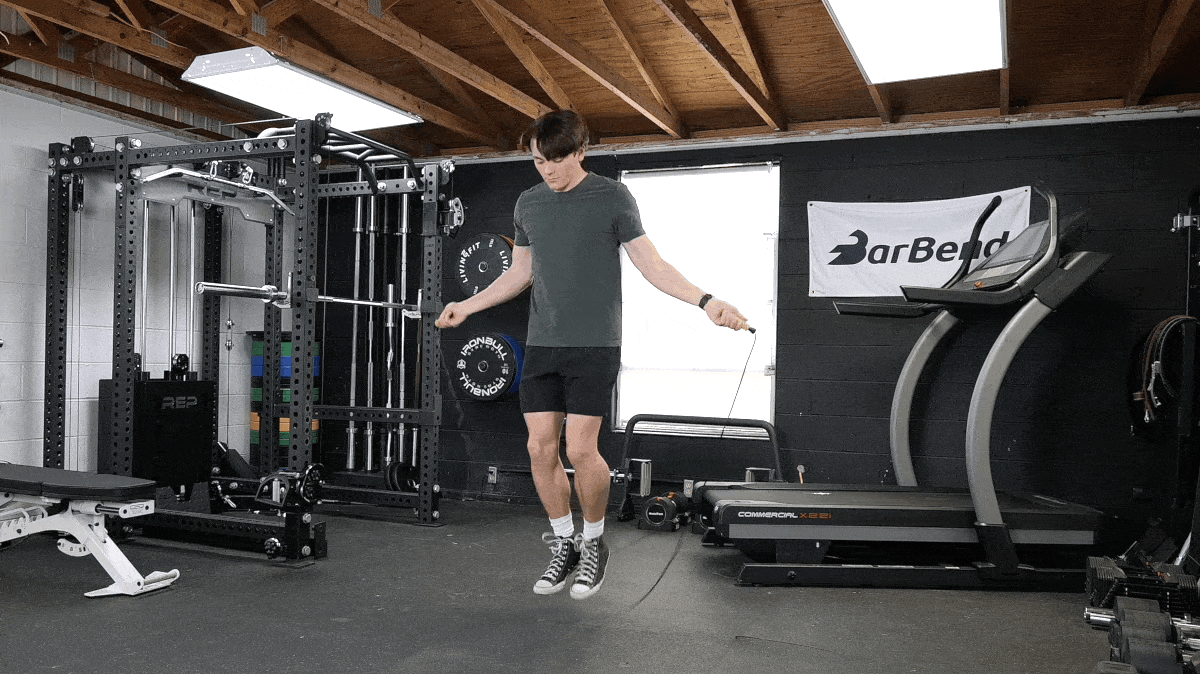You’ve seen the inspirational training montages. If they’re even remotely related to a boxer (Creed, anyone), you’ll be sure to see a whole lot of jump rope workouts right in there with chain pull-ups, dropping sweat into garbage bags, endless sprints, and fancy footwork.
Or maybe you’re coming from the CrossFit world instead of boxing. Or…you just want a way to train at home without a whole bunch of heavy, expensive equipment clogging your entryway and bank account.

No matter the reason you’re turning to jump ropes, they’re an unbeatable tool for cardio training. To help you jump into your training feet first, I sat down for a discussion with NCSF-certified personal trainer John Holt (who also happens to be one of the best Muay Thai fighters on the planet). He gave me three of the best jump rope workouts out there.
Try These 3 Best Jump Rope Workouts
In addition to being a CPT, Holt is also a certified instructor of several forms of unarmed combat, and was once one of the top-ranked Muay Thai fighters in the world. Without a doubt, Holt has spent plenty of time spinning jump ropes underneath his feet. Here are his recommendations.
10-Minute Beginner Jump Rope Workout
There are several ways to be a beginner at jumping rope. You might be aiming to do a couch-to-jump-rope program of sorts if you generally haven’t been a cardio person yet. Or you might be a strength athlete or even a runner who just hasn’t picked up a jump rope since the playground days.
“Before we worry about conditioning or intensity, I would focus on technique and rhythm,” says Holt. “The easiest way to teach this is to start with the crossover. It requires no leg coordination and just a very simple movement of making an X with your jump rope in front of your body and letting it pass to your right or left.”
The Workout
For a beginner workout that can help you develop all three facets of jumping rope—the cardiovascular, coordination, and endurance elements—Holt recommends incorporating the crossover rope pattern. This method familiarizes you with the movements of jumping rope, and it can also serve as an effective warm up or cool down.
[Read More: How to Measure a Jump Rope: Easy Steps To Find The Right Length]
“The crossover is a simple, whole beat movement,” adds Holt. “Once you can do the basic X-pattern, you can add in a single jump over the rope on the third beat. So you can go crossover left, crossover right, then jump over the rope with both feet. An excellent beginner 10-minute routine would be five two-minute rounds practicing this pattern.”

- Five minutes: Crossover left, Crossover right, Jump
- Two minutes: Rest
- Five minutes: Crossover left, Crossover right, Jump
How Often to Do This Workout: Every day
Modifications
- Make it Easier: Reduce the number of jumps in between X-pattern swings to one jump every second or third cycle.
- Make it Harder: Increase the number of jumps in between each set of X-pattern swings to two or more jumps.
Jump Rope HIIT Workout
With a jump rope in your hand, your rate of exertion is entirely self-governed, meaning that you can deliver an all-out effort in a confined space. Even if you have limited time to spare, you can still reap the benefits of a physically challenging workout. What’s more, you can develop substantial jumping power while strengthening the muscles of your glutes, quads, hamstrings and calves.
[Read More: The Best HIIT Cardio Workout for Beginners (+ Customizations for Every Fitness Level)]
“The jump rope is a unique tool that allows for simultaneous training of speed and intensity,” explains Holt. “These are vital traits for any athlete, and were especially useful to me during my pro fight career.”
The Workout
This high-intensity interval training (HIIT) workout will boost your endurance and jumping power. You will be giving it everything you have in 20-second bursts of speed and power with limited recovery time. Completing this collection of movements will make you fast and agile, with legs that are suitably conditioned for making jumps of all kinds.
“I have seen excellent progress with Tabata intervals to help athletes simultaneously develop endurance and power,” says Holt. “So 20 seconds of intense work, followed by a 10-second rest, which is an excellent opportunity to work on breath control and lowering the heart rate quickly. For combat athletes, I would also use this as time to work on keeping the hands up while fatigued.”
Complete three full rounds of the following routine:

- 20 seconds: Boxer shuffle
- 10 seconds: Rest
- 20 seconds: Two foot sprin g jumping
- 10 seconds: Rest
- 20 seconds: High knees
- 10 seconds: Rest
- 20 seconds: Double-unders
- 10 seconds: Rest
- 20 seconds: Alternate running forward five steps and backward five steps
- 10 seconds: Rest
- 20 seconds: Jumping jacks crossing ankles on the inward skip
How Often to Do This Workout: Every other day
Modifications
- Make it Easier: Complete only one set of the workout, or replace the double-unders and spring jumps with regular fast-paced rope skipping.
- Make it Harder: Complete five full rounds of the series.
Jump Rope Cardio Workout
For an all-purpose cardiovascular jump rope workout, you have to pace yourself carefully, and you’ll also want to vary your fundamental movement pattern to keep yourself from getting bored. Because of his extensive background as a fighter, Holt recommends that you include a lot of different movements in your jump rope cardio, and also several different rope speeds.
“I was always taught to make your prep work more difficult than the actual fight, so by contrast the challenge of fighting is lessened,” says Holt. “For a scenario like this, I would coach athletes to work both high- and low-intensity variables in a freeform style to mimic the ever changing pace of a ring fight.”
[Read More: The Best Cardiovascular Exercises, Plus Cardio Workouts From a CPT]
This isn’t just for fighters, though: the same challenges will improve everything from power and stamina to coordination and breath control for any athlete.
The Workout
In keeping with his fighting background, Holt suggests structuring your training around a series of rounds, with plenty of rest, and plenty of variations in the way you move. This way, you train all of your energy systems while establishing a durable aerobic base.
“In the beginning, the goal isn’t to reach a high level of fatigue or increase your cardio, but to do each movement as perfectly as possible,” advises Holt. “It’s far better to take your time and eliminate bad habits before you try to push yourself. I would structure longer cardio routines based on the intervals of fight rounds, with the same rest times in between. For fighters, I would include maybe two to five extra rounds beyond the length of whatever fight they’re preparing for.”
Complete the following in two minute 10 rounds, with one minute of rest between rounds:

- Round One: Regular rope skips
- Round Two: Boxer shuffles
- Round Three: Alternating feet every four skips
- Round Four: High knees
- Round Five: Feet moving in and out in a jumping jack pattern
- Round Six: Regular rope kips
- Round Seven: Boxer shuffles
- Round Eight: Alternating feet every four skips
- Round Nine: High knees
- Round 10: Feet moving in and out in a jumping jack pattern
How Often to Do This Workout: Every other day
Modifications
- Make it Easier: Decrease the number of rounds to five, or limit the jumping variety to regular skips and boxer shuffles.
- Make it Harder: Increase the duration of each round to three minutes, limit the rest to 30 seconds, and do double-unders for the final 10 seconds of each round.
How to Jump Rope Properly
Citing his time spent training as a professional fighter, Holt encourages you to ditch the weighted jump rope and exclusively train with traditional lightweight skipping ropes. He also encourages you to jump on surfaces conducive to continual jump rope training like wood floors, outdoor tracks, tennis courts, and even boxing rings. Finally, Holt insists that you start with the proper length of rope.

[Read More: The Best Jump Rope Workout for Beginners, Catered to Your Goals]
“Most places like Amazon carry nine-foot ropes, which work well for people under six feet tall,” suggests Holt. “Taller folks might need a 10-foot rope. An ideal rope should reach your armpit when you stand in the middle. You can also tie knots to shorten the rope as a reversible option; you could trim the rope, but you can’t add that length back.”
The Jump Rope Process
- Hold the handles of the rope down at your sides in a relaxed, but firm grip.
- Stand with your legs about shoulder-width apart.
- Rotate from your wrists with minimal arm movement between your armpits and your elbows to raise the rope over your head and in front of your body.
- Jump over the rope and allow it to pass beneath your feet.
- Repeat the process as long as necessary.
Holt also wants you to make sure you retain the correct posture throughout the duration of your jump rope training.
“Keep your spine straight, your shoulders down, and your elbows close to your body,” instructs Holt. “Once you start jumping, regardless of variation, stay on the balls of your feet for the duration of the round.”
Benefits of Jump Rope Workouts
The low-impact nature of jump rope workouts makes them a tremendous tool to have in your arsenal. They are a safe means of achieving a host of highly sought-after physical benefits within a confined space. In fact, the unique all-in-one assortment of jump rope benefits might quickly make it your preferred means of cardiovascular training, over and above all others.
You’ll Get Stronger
Studies have demonstrated that jumping rope—especially when using a weighted rope—has been linked to strength gains in both the upper body and lower body. (1) You won’t receive the same gains you’d expect from consistent strength training, but jumping rope can be a solid contributor to that plan. It also pairs very easily with exercises like bodyweight squats and push-ups.
You’ll Improve Your Coordination
More than one study has linked jumping rope to improved coordination. (2) This should come as no surprise; an average routine will have you mastering single-leg jumps on your right foot, then have you transfer over to your alternate foot.
[Read More: The Best Battle Rope Workouts to Make Waves in Your Training]
All of these complex movements take increasing levels of coordination and control to perform well.
Endurance
If you want to build up your cardiorespiratory endurance, the right jump rope routine can help to boost your endurance level as reliably as running outside or on a treadmill. One particular study showcased how jump rope training improved the three-kilometer running performance of amateur endurance runners. (3)
Weight Loss
Jumping rope can cause the exact sort of caloric burn that contributes to a calorie deficit, and ultimately results in fat loss. A 150-pound person who jumps rope at a pace of 100 to 120 skips per minute can expect to burn about 140 calories in 10 minutes.
Frequently Asked Questions
How long should I jump rope for a good workout?
A simple 10-minute jump rope workout can serve as a full-body workout that gets your heart rate up and burns plenty of calories (if that’s one of your goals). These workouts could also meaningfully boost your overall fitness level if they were repeated frequently enough.
Can I lose belly fat by jumping rope?
While jumping rope will not directly burn belly fat, it can contribute to the creation of a caloric deficit. Therefore, jumping rope—in concert with a sustainable nutrition plan—can create the sort of caloric deficit that eventually results in the elimination of belly fat.
What is 10 minutes of jumping rope equivalent to?
The number of calories you are capable of burning during a jump rope workout is dependent upon your weight, and the intensity level of your jumping.
As an example, a 150-pound person who jumps rope at a pace of 100 to 120 skips per minute should expect to burn about 140 calories in 10 minutes. A 200-pound person should expect to burn nearly 190 calories under the same conditions.
References
- Ozer D, Duzgun I, Baltaci G, Karacan S, Colakoglu F. The effects of rope or weighted rope jump training on strength, coordination and proprioception in adolescent female volleyball players. J Sports Med Phys Fitness. 2011 Jun;51(2):211-9.
- Trecroci A, Cavaggioni L, Caccia R, Alberti G. Jump Rope Training: Balance and Motor Coordination in Preadolescent Soccer Players. J Sports Sci Med. 2015 Nov 24;14(4):792-8.
- García-Pinillos F, Lago-Fuentes C, Latorre-Román PA, Pantoja-Vallejo A, Ramirez-Campillo R. Jump-Rope Training: Improved 3-km Time-Trial Performance in Endurance Runners via Enhanced Lower-Limb Reactivity and Foot-Arch Stiffness. Int J Sports Physiol Perform. 2020 Mar 12;15(7):927-933.
Featured Image: bbernard / Shutterstock